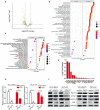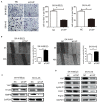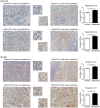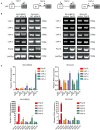Prp19 Is an Independent Prognostic Marker and Promotes Neuroblastoma Metastasis by Regulating the Hippo-YAP Signaling Pathway
- PMID: 33224878
- PMCID: PMC7667276
- DOI: 10.3389/fonc.2020.575366
Prp19 Is an Independent Prognostic Marker and Promotes Neuroblastoma Metastasis by Regulating the Hippo-YAP Signaling Pathway
Abstract
Pre-mRNA processing factor 19 (Prp19) was previously reported to be involved in tumor progression. However, Prp19 expression and its functions remain elusive in neuroblastoma. Here, we aim to identify the functions and mechanisms of Prp19 in neuroblastoma. Neuroblastic tumor tissue microarrays and two independent validation data sets indicate that Prp19 is associated with high-risk markers and bone marrow metastasis and serves as a prognostic marker for worse clinical outcomes with neuroblastoma. Gain- and loss-of-expression assays reveal that Prp19 promotes invasion, migration, and epithelial-mesenchymal transition (EMT) of neuroblastoma cells in vitro. Bioinformatics analysis of RNA-seq data shows that the expressions of YAP and its downstream genes are significantly inhibited after downregulation of Prp19. Prp19 and YAP expression in metastatic lymph nodes is higher than in situ neuroblastoma tissue. Further experiments show that Prp19 regulates YAP expression and consequently affects cell invasion, migration, and EMT in neuroblastoma by pre-mRNA splicing of YAP. In conclusion, our findings provide the first evidence that Prp19 is a potential therapeutic target and prognostic biomarker for patients with neuroblastoma.
Keywords: Prp19; RNA splicing; YAP; metastasis; neuroblastoma.
Copyright © 2020 Cai, Chen, Cheng, Xu, Cheng, Xu, Wu and Wu.
Figures







Similar articles
-
The PRP19 Ubiquitin Ligase, Standing at the Cross-Roads of mRNA Processing and Genome Stability.Cancers (Basel). 2022 Feb 10;14(4):878. doi: 10.3390/cancers14040878. Cancers (Basel). 2022. PMID: 35205626 Free PMC article. Review.
-
Inhibition of CXCR4 regulates epithelial mesenchymal transition of NSCLC via the Hippo-YAP signaling pathway.Cell Biol Int. 2018 Sep;42(10):1386-1394. doi: 10.1002/cbin.11024. Epub 2018 Jul 17. Cell Biol Int. 2018. PMID: 29972256
-
Prp19 facilitates invasion of hepatocellular carcinoma via p38 mitogen-activated protein kinase/twist1 pathway.Oncotarget. 2016 Apr 19;7(16):21939-51. doi: 10.18632/oncotarget.7877. Oncotarget. 2016. PMID: 26959880 Free PMC article.
-
Furin inhibitor D6R suppresses epithelial-mesenchymal transition in SW1990 and PaTu8988 cells via the Hippo-YAP signaling pathway.Oncol Lett. 2018 Mar;15(3):3192-3196. doi: 10.3892/ol.2017.7672. Epub 2017 Dec 20. Oncol Lett. 2018. PMID: 29435056 Free PMC article.
-
A New Player in Neuroblastoma: YAP and Its Role in the Neuroblastoma Microenvironment.Cancers (Basel). 2021 Sep 16;13(18):4650. doi: 10.3390/cancers13184650. Cancers (Basel). 2021. PMID: 34572875 Free PMC article. Review.
Cited by
-
The PRP19 Ubiquitin Ligase, Standing at the Cross-Roads of mRNA Processing and Genome Stability.Cancers (Basel). 2022 Feb 10;14(4):878. doi: 10.3390/cancers14040878. Cancers (Basel). 2022. PMID: 35205626 Free PMC article. Review.
-
ADGRL4 Promotes Cell Growth, Aggressiveness, EMT, and Angiogenesis in Neuroblastoma via Activation of ERK/STAT3 Pathway.Curr Mol Med. 2025;25(1):45-55. doi: 10.2174/0115665240254765231117122210. Curr Mol Med. 2025. PMID: 38178660
-
An Integrated Analysis of the Identified PRPF19 as an Onco-immunological Biomarker Encompassing the Tumor Microenvironment, Disease Progression, and Prognoses in Hepatocellular Carcinoma.Front Cell Dev Biol. 2022 Feb 17;10:840010. doi: 10.3389/fcell.2022.840010. eCollection 2022. Front Cell Dev Biol. 2022. PMID: 35252202 Free PMC article.
-
Adrenal ganglioneuroma: Prognostic factors (Review).Exp Ther Med. 2021 Nov;22(5):1338. doi: 10.3892/etm.2021.10773. Epub 2021 Sep 22. Exp Ther Med. 2021. PMID: 34630692 Free PMC article. Review.
-
Comprehensive analysis of PRPF19 immune infiltrates, DNA methylation, senescence-associated secretory phenotype and ceRNA network in bladder cancer.Front Immunol. 2023 Nov 6;14:1289198. doi: 10.3389/fimmu.2023.1289198. eCollection 2023. Front Immunol. 2023. PMID: 38022515 Free PMC article.
References
LinkOut - more resources
Full Text Sources
Molecular Biology Databases
Miscellaneous

